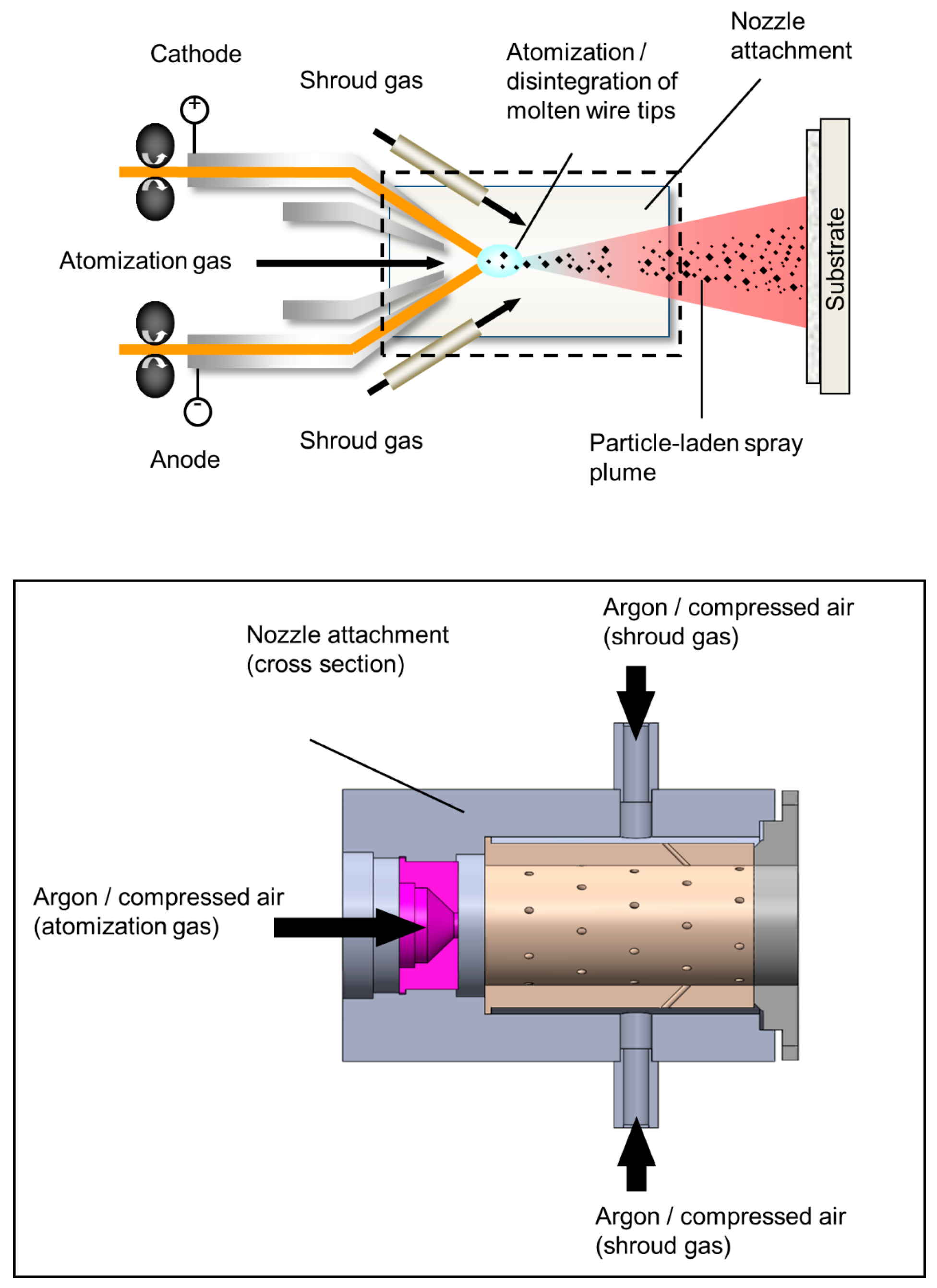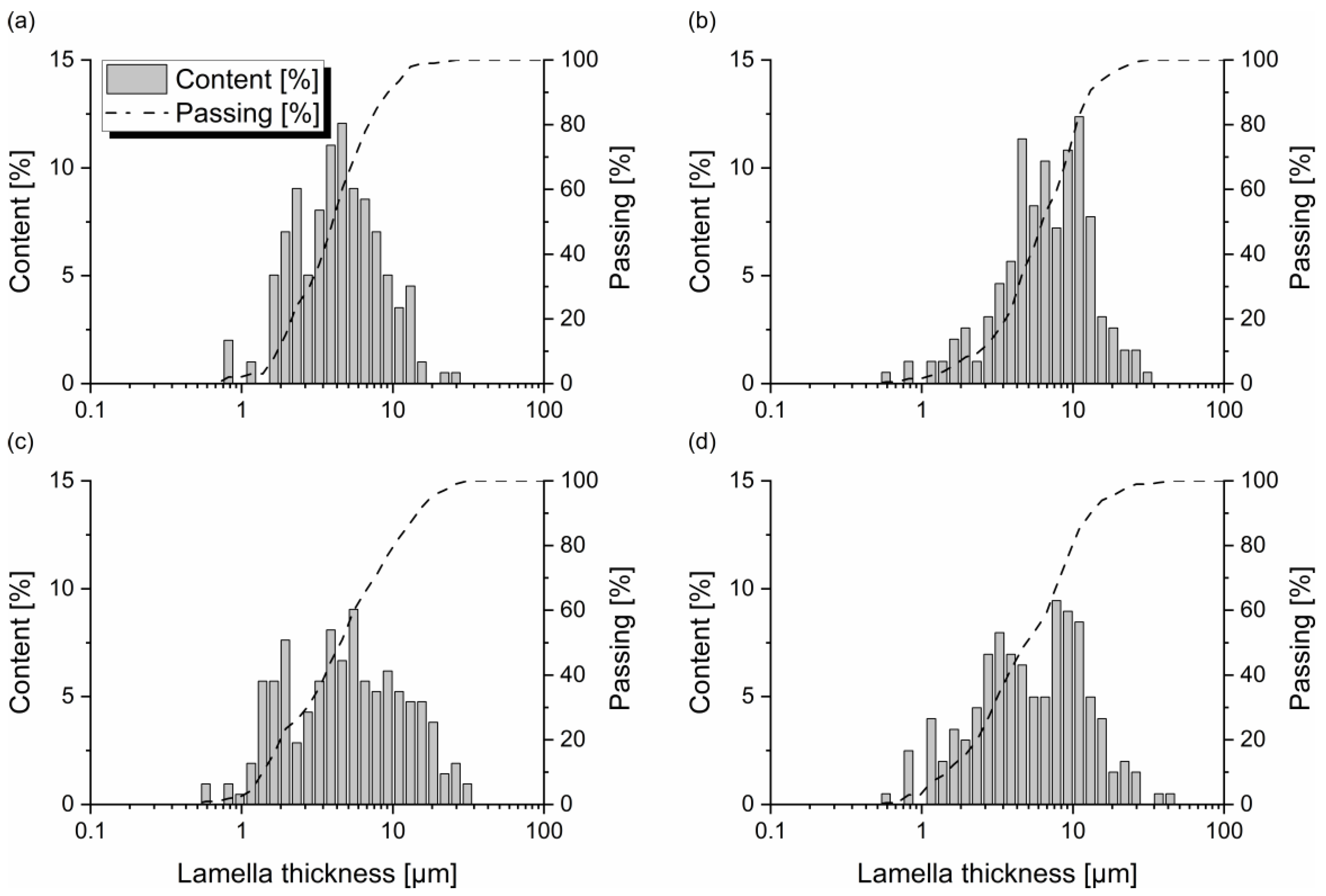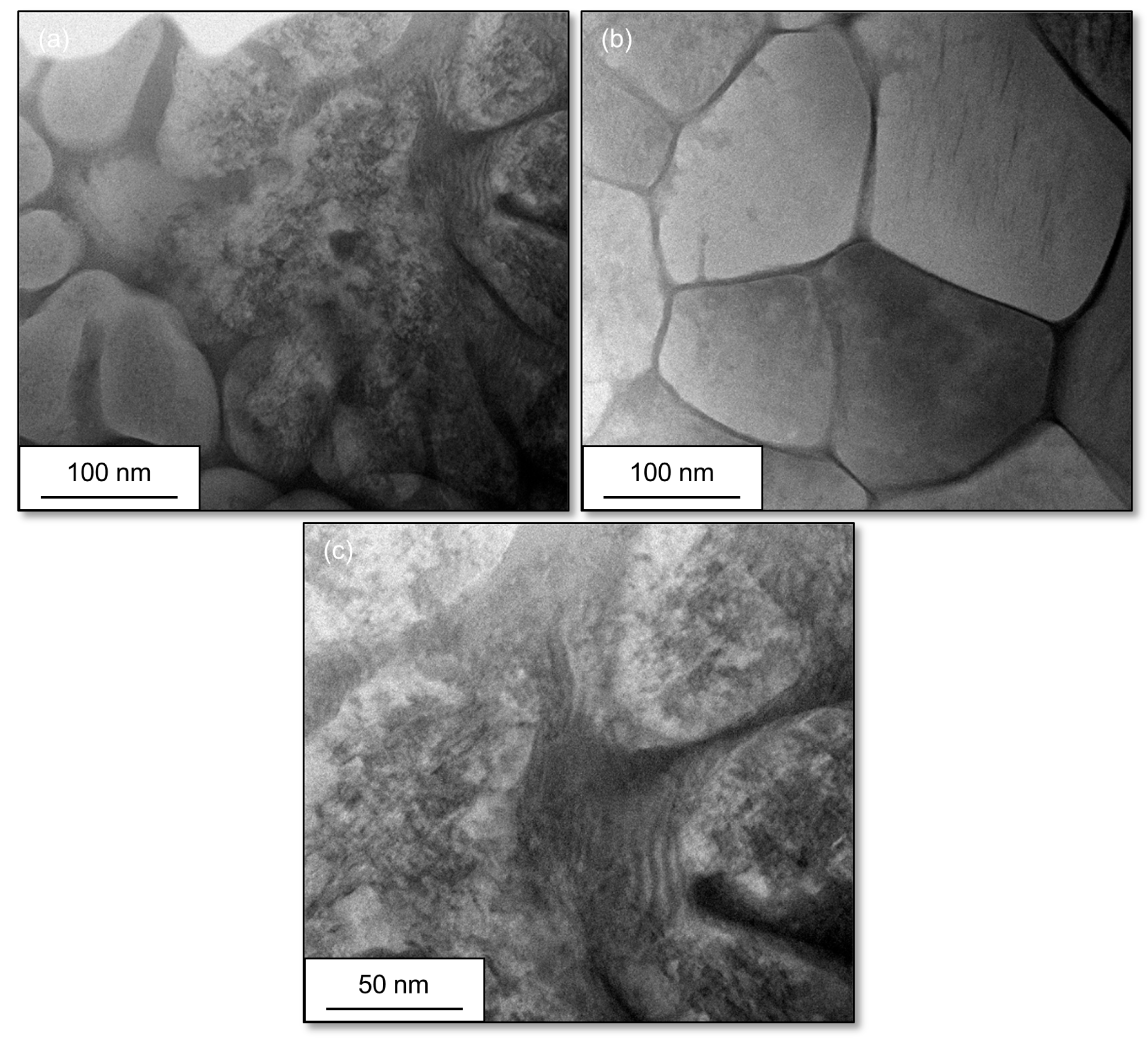Machine Hammer Peening and Its Effect on the Surface Integrity of Arc-Sprayed WC-W2C-FeCMnSi Coatings
Abstract
:1. Introduction
2. Materials and Methods
2.1. Substrate and Feedstock Material
2.2. Spray Parameter
2.3. Machine Hammer Peening Process
2.4. Analytics Methods
3. Results and Discussion
Microstructure
4. Conclusions
- a reduced porosity and lamella thickness due to a densification of the coating microstructure
- an increased hardness due to strain hardening effects based on the formation of dislocations
- an additional introduction of compressive residual stresses which contributes to a decline in tensile residual stresses in the near-surface area
Author Contributions
Funding
Institutional Review Board Statement
Informed Consent Statement
Data Availability Statement
Acknowledgments
Conflicts of Interest
References
- Shipway, P.H.; McCartney, D.G.; Sudaprasert, T. Sliding Wear Behaviour of Conventional and Nanostructured HVOF Sprayed WC–Co Coatings. Wear 2005, 259, 820–827. [Google Scholar] [CrossRef]
- Espallargas, N.; Berget, J.; Guilemany, J.M.; Benedetti, A.V.; Suegama, P.H. Cr3C2–NiCr and WC–Ni Thermal Spray Coatings as Alternatives to Hard Chromium For Erosion-Corrosion Resistance. Surf. Coat. Technol. 2008, 202, 1405–1417. [Google Scholar] [CrossRef]
- Nahvi, S.M.; Jafari, M. Microstructural and Mechanical Properties of Advanced HVOF-Sprayed WC-Based Cermet Coatings. Surf. Coat. Technol. 2016, 286, 95–102. [Google Scholar] [CrossRef]
- Sánchez, E.; Bannier, E.; Salvador, M.D.; Bonache, V.; García, J.C.; Morgiel, J.; Grzonka, J. Microstructure and Wear Behavior of Conventional and Nanostructured Plasma-Sprayed WC-Co Coatings. J. Therm. Spray Tech. 2010, 19, 964–974. [Google Scholar] [CrossRef]
- Berghaus, J.O.; Marple, B.; Moreau, C. Suspension Plasma Spraying of Nanostructured WC-12Co Coatings. J. Therm. Spray Technol. 2006, 15, 676–681. [Google Scholar] [CrossRef]
- He, D.J.; Fu, B.J.; Jiang, J.M.; Li, X.J. Microstructure and wear performance of arc sprayed Fe-FeB-WC coatings. J. Therm. Spray Technol. 2008, 17, 757–761. [Google Scholar] [CrossRef]
- Tillmann, W.; Klusemann, B.; Nebel, J.; Svendsen, B. Analysis of the mechanical properties of an arc-sprayed WC-FeCSiMn coating: Nanoindentation and simulation. J. Therm. Spray Technol. 2011, 20, 328–335. [Google Scholar] [CrossRef]
- Tillmann, W.; Luo, W.; Nebel, J. Einfluss der Hartstoffkorngröße auf die tribologischen Eigenschaften gewalzter und geschliffener WSC-FeCSiMn-Schichten. Therm. Spray Bull. 2011, 4, 56–63. [Google Scholar]
- Tillmann, W.; Luo, W.; Selvadurai, U. Wear analysis of thermal spray coatings on 3D surfaces. J. Therm. Spray Technol. 2014, 23, 245–251. [Google Scholar] [CrossRef]
- Xu, B.; Zhu, Z.; Ma, S.; Zhang, W.; Liu, W. Sliding wear behavior of Fe–Al and Fe–Al/ WC coatings prepared by high velocity arc spraying. Wear 2004, 257, 1089–1095. [Google Scholar] [CrossRef]
- Sheppard, P.; Koiprasert, H. Effect of W dissolution in NiCrBSi–WC and NiBSi–WC arc sprayed coatings on wear behaviors. Wear 2014, 317, 194–200. [Google Scholar] [CrossRef]
- Niranatlumpong, P.; Koiprasert, H. Phase transformation of NiCrBSi–WC and NiBSi–WC arc sprayed coatings. Surf. Coat. Technol. 2011, 206, 440–445. [Google Scholar] [CrossRef]
- Atteridge, D.G.; Davis, R.; Scholl, M.; Tewksbury, G. Twin wire arc and high energy plasma spray coating using nanometer scale WC-Co in powder-filled cored wire. J. Therm. Spray Technol. 2001, 10, 176–177. [Google Scholar]
- U.S. Department of Health and Human Services. Report on Carcinogens, Background Document for Metallic Nickel and Certain Nickel Alloys. Available online: https://ntp.niehs.nih.gov/ntp/newhomeroc/roc10/ni_no_appendices_508.pdf (accessed on 8 June 2023).
- No 790/2009. Commission Regulation (EC). Amending, for the Purposes of Its Adaptation to Technical and Scientific Progress, Regulation (EC) No 1272/2008 of the European Parliament and of the Council on classification, labelling and packaging of substances and mixtures. Official Journal of the European Union L235/1 (5.9.2009). Available online: https://eur-lex.europa.eu/legal-content/EN/TXT/PDF/?uri=CELEX:32009R0790&from=EN (accessed on 8 June 2023).
- Zimmermann, S.; Gries, B.; Fischer, J.; Lugscheider, E. (Eds.) Thermal Spray 2008: Crossing Borders. In Proceedings of the International Thermal Spray Conference, Maastricht, The Netherlands, 2–4 June 2008; DVS Deutscher Verband für Schweißen: Düsseldorf, Germany, 2008. [Google Scholar]
- U.S. Department of Health and Human Services. Cobalt–Tungsten Carbide: Powders and hard metals. In Proceedings of the 12th Report on Carcinogens, Chapel Hill, NC, USA, 9–10 December 2008; Available online: https://ntp.niehs.nih.gov/ntp/roc/twelfth/2008/expertpanelmtgs/cobalt_panelreportpartb_508.pdf (accessed on 8 June 2023).
- Scrivani, A.; Antolotti, N.; Bertini, S.; Groppetti, R.; Gutema, T.; Mangia, A.; Mucchino, S.; Viola, G.; Coddet, C. (Eds.) A Contribution to Methodology and Protocol Definition for Thermal Spray Coated Surface Compatibility Analysis in Food Processing Applications. In Proceedings of the Thermal Spray: Meeting the Challenges of the 21st Century, Nice, France, 25–29 May 1998; ASM International: Almere, The Netherlands, 1998; p. 1019. [Google Scholar]
- Abkenar, A.H.P. Wire-Arc Spraying System: Particle Production, Transport, and Deposition; Library and Archives Canada, Library and Archives Canada, University of Toronto: Toronto, ON, Canada, 2007. [Google Scholar]
- Pourmousa, A.; Mostaghimi, J.; Abedini, A.; Chandra, S. Particle Size Distribution in a Wire-Arc Spraying System. J. Therm. Spray. Tech. 2005, 14, 502–510. [Google Scholar] [CrossRef]
- Planche, M.P.; Liao, H.; Coddet, C. Relationships between InFlight Particle Characteristics and Coating Microstructure with a Twin Wire Arc Spray Process and Different Working Conditions. Surf. Coat. Technol. 2004, 182, 215–226. [Google Scholar] [CrossRef]
- Newbery, A.P.; Grant, P.S.; Neiser, R.A. The Velocity and Temperature of Steel Droplets during Electric Arc Spraying. Surf. Coat. Technol. 2005, 195, 91–101. [Google Scholar] [CrossRef]
- Liao, H.L.; Zhu, Y.L.; Bolot, R.; Coddet, C.; Ma, S.N. Size Distribution of Particles from Individual Wires and the Effects of Nozzle Geometry in Twin Wire Arc Spraying. Surf. Coat. Technol. 2005, 200, 2123–2130. [Google Scholar] [CrossRef]
- Hussary, N.A.; Heberlein, J.V.R. Effect of System Parameters on Metal Breakup and Particle Formation in the Wire Arc Spray Process. J. Therm. Spray. Tech. 2007, 16, 140–152. [Google Scholar] [CrossRef]
- Kelkar, M.; Heberlein, J. Wire-Arc Spray Modeling. Plasma Chem. Plasma Process. 2002, 22, 1–25. [Google Scholar] [CrossRef]
- Hussary, N.A.; Heberlein, J.V.R. Atomization and Particle-Jet Interactions in the Wire-Arc Spraying Process. J. Therm. Spray Tech. 2001, 10, 604–610. [Google Scholar] [CrossRef]
- Fang, J.J.; Li, Z.X.; Qian, M.; Ren, C.L.; Shi, Y.W. Effects of powder size in cored wire on arc-sprayed metal-ceramic coatings, global coating solutions. In Proceedings of the 2007 International Thermal Spray Conference, Beijing, China, 14–16 May 2007; Marple, B.R., Ed.; ASM International: Almere, The Netherlands, 2007; pp. 365–370. [Google Scholar]
- Boronenkov, V.; Korobov, Y. Fundamentals of Arc Spraying; Springer International Publishing: Berlin/Heidelberg, Germany, 2016. [Google Scholar]
- Paczkowski, G.; Rupprecht, C.; Wielage, B. Hochgeschwindigkeitslichtbogenspritzen—Die Renaissance eines Beschichtungsverfahrens. Therm. Spray Bull. 2012, 5, 140–147. [Google Scholar]
- Newbery, A.P.; Grant, P.S. Oxidation during Electric Arc Spray Forming of Steel. J. Mater. Process. Technol. 2006, 178, 259–269. [Google Scholar] [CrossRef]
- Zurecki, Z.; Garg, D.; Bowe, D. Electric arc deposition of carbon steel coatings with improved mechanical properties. J. Therm. Spray Technol. 1997, 6, 417–421. [Google Scholar] [CrossRef]
- Gedzevicius, I.; Valiulis, A.V. Analysis of Wire Arc Spraying Process Variables on Coatings Properties. J. Mater. Process. Technol. 2006, 175, 206–211. [Google Scholar] [CrossRef]
- Jandin, G.; Liao, H.; Feng, Z.Q.; Coddet, C. Correlations between Operating Conditions, Microstructure and Mechanical Properties of Twin Wire Arc Sprayed Steel Coatings. Mater. Sci. Eng. A 2003, 349, 298–305. [Google Scholar] [CrossRef]
- Hauer, M.; Banaschik, R.; Kroemmer, W.; Henkel, K.M. Variation of Heat Input and Its Influence on Residual Stresses and Coating Properties in Arc Spraying with Different Gas Mixtures. J. Therm. Spray Technol. 2019, 28, 40–52. [Google Scholar] [CrossRef]
- Sakoda, N.; Hida, M.; Takemoto, Y.; Sakakibara, A.; Tajiri, T. Influence of atomization gas on coating properties under Ti arc spraying. Mater. Sci. Eng. 2003, 264–269. [Google Scholar] [CrossRef]
- Wang, X.; Heberlein, J.; Pfender, E.; Gerberich, W. Effect of nozzle configuration, gas pressure, and gay type on coating properties in wire arc spray. J. Therm. Spray Technol. 1999, 8, 565–575. [Google Scholar] [CrossRef]
- Fussel, P.S.; Kirchner, H.O.K.; Prinz, F.B.; Weiss, L.E. Controlled microstructure of arc-sprayed metal shells. J. Therm. Spray Technol. 1994, 3, 148–161. [Google Scholar] [CrossRef]
- Daillaire, S.; Levert, H. Synthesis and deposition of TiB2-containing materials by arc spraying. Surf. Coat. Technol. 1992, 50, 241–248. [Google Scholar] [CrossRef]
- Milewski, W.; Sartowski, M. Some properities of coatings arc-sprayed in nitrogen or argon atmosphere. In Advances in Thermal Spraying; Pergamon Press: Oxford, UK, 1986; pp. 467–473. [Google Scholar]
- Steffens, H.D. Thermisches Spritzen von Stahlwerkstoffen in Schutzgasatmosphäre; Habilitationsschrift, Technische Universität Hannover: Hannover, Germany, 1967. [Google Scholar]
- Tillmann, W.; Abdulgader, M. Wire Composition: Its Effect on Metal Disintegration and Particle Formation in Twin-Wire Arc-Spraying Process. J. Therm. Spray Tech. 2013, 22, 352–362. [Google Scholar] [CrossRef]
- Tillmann, W.; Hagen, L.; Kokalj, D. Embedment of eutectic tungsten carbides in arc sprayed steel coatings. Surf. Coat. Technol. 2017, 331, 153–162. [Google Scholar] [CrossRef]
- Kuroda, S.; Clyne, T.W. The Quenching Stress in Thermally Sprayed Coatings. Thin Solid Film. 1991, 200, 49–66. [Google Scholar] [CrossRef]
- Chen, Y.; Liang, X.; Liu, Y.; Xu, B. Prediction of Residual Stresses in Thermally Sprayed Steel Coatings Considering the Phase Transformation Effect. Mater. Des. 2010, 31, 3852–3858. [Google Scholar] [CrossRef]
- Matejicek, J.; Sampath, S. Intrinsic Residual Stresses in Single Splats Produced by Thermal Spray Processes. Acta Mater. 2001, 49, 1993–1999. [Google Scholar] [CrossRef]
- Pina, J.; Dias, A.; Lebrun, J. Study by X-Ray Diffraction and Mechanical Analysis of the Residual Stress Generation during Thermal Spraying. Mater. Sci. Eng. A 2003, 347, 21–31. [Google Scholar] [CrossRef]
- Weglewski, W.; Basista, M.; Manescu, A.; Chmielewski, M.; Pietrzak, K.; Schubert, T. Effect of Grain Size on Thermal Residual Stresses and Damage in Sintered Chromium-Alumina Composites: Measurement and Modeling. Compos. B Eng. 2014, 67, 119–124. [Google Scholar] [CrossRef]
- Santana, Y.Y.; La Barbera-Sosa, J.G.; Staia, M.H.; Lesage, J.; Puchi-Cabrera, E.S.; Chicot, D.; Bemporad, E. Measurement of Residual Stress in Thermal Spray Coatings by the Incremental Hole Drilling Method. Surf. Coat. Technol. 2006, 201, 2092–2098. [Google Scholar] [CrossRef]
- Scheil, J.; Müller, C.; Steitz, M.; Groche, P. Influence of process parameters on surface hardening in hammer peening and deep rolling. Key Eng. Mater. 2013, 554–557, 1819–1827. [Google Scholar] [CrossRef]
- Wied, J. Oberflächenbehandlung von Umformwerkzeugen Durch Festklopfen; TU Darmstadt: Darmstadt, Germany, 2011. [Google Scholar]
- Tai, M.; Miki, C.; Suzuki, K. Mechanism of Fatigue Strength Improvement by Applying Peening Treatment. Procedia Eng. 2011, 14, 117–125. [Google Scholar] [CrossRef]
- Wirtz, A.; Abdulgader, M.; Milz, M.P.; Tillmann, W.; Walther, F.; Biermann, D. Thermally assisted machine hammer peening of arc-sprayed ZnAl-based corrosion protective coatings. J. Manuf. Mater. Process. 2021, 5, 109. [Google Scholar] [CrossRef]
- Milz, M.P.; Wirtz, A.; Abdulgader, M.; Biermann, D.; Tillmann, W.; Walther, F. Fatigue Assessment of Twin Wire Arc Sprayed and Machine Hammer-Peened ZnAl4 Coatings on S355 JRC + C Substrate. Materials 2022, 15, 1182. [Google Scholar] [CrossRef] [PubMed]
- Milz, M.P.; Wirtz, A.; Abdulgader, M.; Kalenborn, A.; Biermann, D.; Tillmann, W.; Walther, F. Corrosion Fatigue Behavior of Twin Wire Arc Sprayed and Machine Hammer-Peened ZnAl4 Coatings on S355 J2C + C Substrate. Corros. Mater. Degrad. 2022, 3, 127–141. [Google Scholar] [CrossRef]
- Rausch, S.; Wiederkehr, P.; Biermann, D. Machine Hammer Peening of Wear Resistant Thermally Sprayed Coatings. In Proceedings of the 12th International Conference THE ‘‘A’’ Coatings, Hannover, Germany, 31 March–1 April 2016; pp. 115–121. [Google Scholar]
- Rausch, S.; Wiederkehr, P.; Biermann, D.; Zabel, A.; Selvadurai, U.; Hagen, L.; Tillmann, W. Influence of machine hammer peening on the tribological behavior and the residual stresses of wear resistant thermally sprayed coatings. Procedia CIRP 2016, 45, 275–278. [Google Scholar] [CrossRef]
- Tillmann, W.; Hagen, L.; Schröder, P. Investigation on the tribological behavior of arc-sprayed and hammer-peened coatings using tungsten carbide cored wires. J. Therm. Spray Technol. 2017, 26, 229–242. [Google Scholar] [CrossRef]
- Oliver, W.C.; Pharr, G.M. An Improved Technique for Determining Hardness and Elastic Modulus Using Load and Displacement Sensing Indentation Experiments. J. Mater. Res. 1992, 7, 1564–1583. [Google Scholar] [CrossRef]
- Tillmann, W.; Selvadurai, U.; Luo, W. Measurement of the Young’s Modulus of Thermal Spray Coatings By Means of Several Methods. J. Therm. Spray Technol. 2013, 22, 290–298. [Google Scholar] [CrossRef]
- Chiu, C.C.; Case, E.D. Elastic Modulus Determination of Coating Layers as Applied to Layered Ceramic Composite. Mater. Sci. Eng. 1991, A132, 39–47. [Google Scholar] [CrossRef]
- DIN EN 843-2; Mechanische Eigenschaften Monolithischer Keramik Bei Raumtemperatur (Mechanical Properties of Monolithic Ceramics at Room Temperature). German Institute for Standardization: Berlin/Heidelberg, Germany, 2006. (In German)
- Czichos, H.; Saito, T.; Smith, L.R. Springer Handbook of Materials Measurement Methods; Springer: Berlin/Heidelberg, Germany, 2006. [Google Scholar]
- Material Properties Database. Available online: https://www.makeitfrom.com/material-properties/SAE-AISI-1045-S45C-C45-1.0503-G10450-Carbon-Steel (accessed on 8 June 2023).
- Tillmann, W.; Hagen, L.; Luo, W.; Chehreh, A.B. Microstructural characteristics and residual stresses in arc-sprayed cermet coatings using different carbide grain size fractions. J. Therm. Spray Technol. 2018, 27, 1103–1122. [Google Scholar] [CrossRef]
- Guo, W.; Wu, Y.; Zhang, J.; Yuan, W. Effect of the long-term heat treatment on the cyclic oxidation behaviour of Fe-based amorphous/nanocrystalline coatings prepared by high-velocity arc spray process. Surf. Coat. Technol. 2016, 307, 392–398. [Google Scholar] [CrossRef]
- Cheng, J.; Zhao, S.; Liu, D.; Feng, Y.; Liang, X. Microstructure and fracture toughness of the FePSiB-based amorphous/nanocrystalline coatings. Mater. Sci. Eng. A 2017, 696, 341–347. [Google Scholar] [CrossRef]
- Schajer, G.S. Practical Residual Stress Measurement Methods; John Wiley & Sons: Hoboken, NJ, USA, 2013. [Google Scholar]
- Jindal, U.C. Experimental Stress Analysis; Dorling Kindersley: London, UK, 2013. [Google Scholar]








| Specimen | Atomization Gas Type | Secondary/Shroud Gas Type | Surface Condition |
|---|---|---|---|
| CA-non-MHP | compressed air | compressed air | non-MHP |
| CA-MHP | compressed air | compressed air | MHP |
| Ar-non-MHP | argon | argon | non-MHP |
| Ar-MHP | argon | argon | MHP |
| Microstructural Characteristic | Sample | |||
|---|---|---|---|---|
| Ar-MHP | Ar-non-MHP | CA-MHP | CA-non-MHP | |
| Porosity, % | 3.8 ± 0.7 | 6.3 ± 1.7 | 2.2 ± 0.4 | 2.7 ± 0.3 |
| Lamella thickness, µm | 6.4 ± 5.6 | 6.8 ± 5.7 | 5.0 ± 3.3 | 7.5 ± 6.3 |
| Vickers microhardness, HV0.5 | 711 ± 272 | 604 ± 208 | 752 ± 152 | 621 ± 121 |
| Hardness, GPa | 5.6 ± 2.1 | 5.1 ± 2.4 | 5.6 ± 1.3 | 5.1 ± 1.6 |
Disclaimer/Publisher’s Note: The statements, opinions and data contained in all publications are solely those of the individual author(s) and contributor(s) and not of MDPI and/or the editor(s). MDPI and/or the editor(s) disclaim responsibility for any injury to people or property resulting from any ideas, methods, instructions or products referred to in the content. |
© 2023 by the authors. Licensee MDPI, Basel, Switzerland. This article is an open access article distributed under the terms and conditions of the Creative Commons Attribution (CC BY) license (https://creativecommons.org/licenses/by/4.0/).
Share and Cite
Hagen, L.; Baumann, J.; Heidelmann, M.; Biermann, D.; Tillmann, W. Machine Hammer Peening and Its Effect on the Surface Integrity of Arc-Sprayed WC-W2C-FeCMnSi Coatings. Coatings 2023, 13, 1563. https://doi.org/10.3390/coatings13091563
Hagen L, Baumann J, Heidelmann M, Biermann D, Tillmann W. Machine Hammer Peening and Its Effect on the Surface Integrity of Arc-Sprayed WC-W2C-FeCMnSi Coatings. Coatings. 2023; 13(9):1563. https://doi.org/10.3390/coatings13091563
Chicago/Turabian StyleHagen, Leif, Jonas Baumann, Markus Heidelmann, Dirk Biermann, and Wolfgang Tillmann. 2023. "Machine Hammer Peening and Its Effect on the Surface Integrity of Arc-Sprayed WC-W2C-FeCMnSi Coatings" Coatings 13, no. 9: 1563. https://doi.org/10.3390/coatings13091563
APA StyleHagen, L., Baumann, J., Heidelmann, M., Biermann, D., & Tillmann, W. (2023). Machine Hammer Peening and Its Effect on the Surface Integrity of Arc-Sprayed WC-W2C-FeCMnSi Coatings. Coatings, 13(9), 1563. https://doi.org/10.3390/coatings13091563











